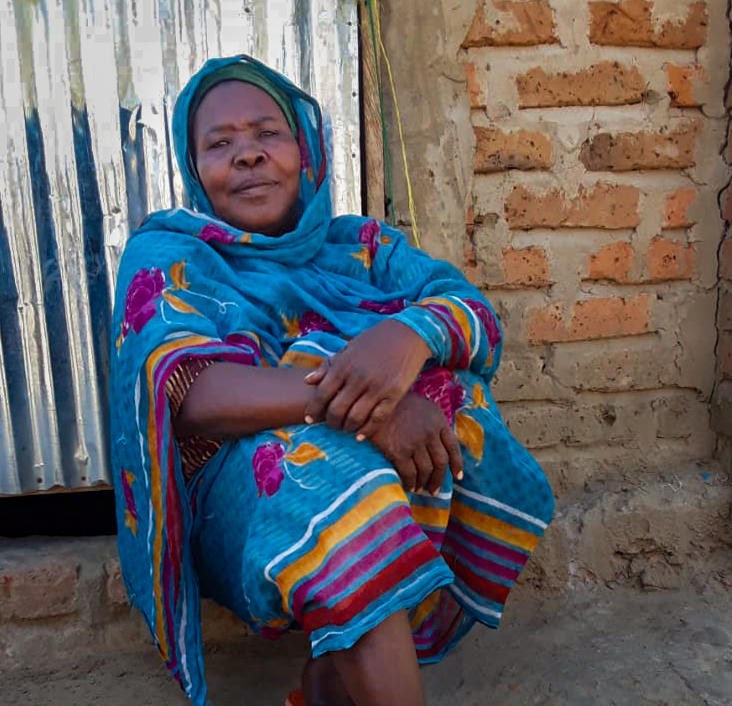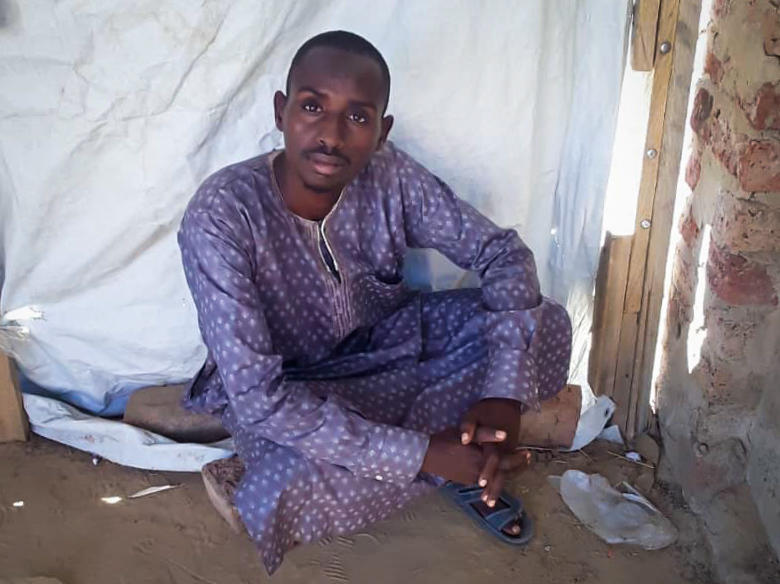Section Branding
Header Content
A new kind of climate refugee is emerging
Primary Content
Updated December 2, 2022 at 10:31 AM ET
Haoua Ali Beta is a new kind of refugee.
She left her home in northeastern Cameroon because of a conflict, like many other refugees, but the conflict in question was driven by climatic changes, not geopolitics.
Haoua's family had reared cattle for generations, but over the past couple of decades, the landscape around her had grown increasingly inhospitable.
"During our grandparents' time, the harvest was good," she explains from the Guilmay refugee camp in southwestern Chad. "These days farming is not good. You know when you overexploit the land for many years, the land's fertility is depleted."
A lack of regular rainfall made the day-to-day task of finding enough water for her family's animals increasingly difficult. "The cattle cannot survive without water," explains the 50-year-old, peeling vegetables into a pot on a mat outside her temporary brick home. "The cattle had to move further away to get water."
That movement of cattle brought the community to which Haoua belongs, known as Choua Arabs, into direct competition with another local group, called the Mousgoum, who relied on the region's rivers and streams to catch fish. The Choua Arabs drove their cattle to streams in which Mousgoum fishermen had dug channels to encourage fish to congregate, and those channels often caused accidents with the animals as they tried to drink. Disputes between the two sides began as simple name-calling then escalated into occasional physical altercations, Haoua says.
Pressures and tensions mounted until last December when they exploded into a conflagration of unprecedented intra-communal violence centered around the Cameroonian town of Kousseri.
And that's when Haoua packed up whatever meager possessions she could carry and set out for Cameroon's border with Chad, where she was months later housed in the Guilmay camp.
There are tens of thousands of other refugees like Haoua who fled climate-triggered violence scattered across the vast scrubland to the south of the Sahara desert. It's a region known as the Sahel, encompassing almost a dozen countries. Given the widespread poverty and subsistence farming and livestock rearing that characterizes much of the region, it is more vulnerable to climate change than almost any other region on earth.
Conflicts driven by the changing climate — amid growing competition for natural resources — are increasingly common in the Sahel. Not only are they causing large numbers of people to cross inhospitable territories, but they are starting to reshape the way communities access food and water in the wider region.
The violence that Haoua witnessed was devastating. "Men start killing each other," she recalls. "Villages and houses were burned, People were killed and burned. People were decapitated," she concludes, making a chopping motion with one hand on top of another. "Women and children were killed."
Cameroonian authorities say that the death toll topped 150, and authorities in neighboring Chad announced that some 30,000 people from both communities had over several days fled across the international border to relative safety. More than 3,000 Choua Arabs, like Haoua, have since settled in the Guilmay refugee camp, a collection of homes with sun-baked brick walls and corrugated metal roofs that Chad's officials raced to build from scratch over several months with help from partners like the United Nations refugee agency, UNHCR.
Almost overnight Haoua's greatest challenge became feeding herself and her family members through a combination of foraging, barter and handouts from the UN's World Food Program — or WFP.
"Of course there are difficulties," says Haoua of her new circumstances. "When you leave your own home and come as a guest to another place, you should expect things to be different. You obviously have to accept whatever you are given."
Refugees in limbo
Competition for resources has become an increasingly common reason for people to abandon their homes in the vast swathe of the African continent to the south of the Sahara desert, known as the Sahel, according to Brice Degla, head of the UNHCR's efforts to support the Cameroonian communities in Chad. "Climate change is not a reason to grant refugee status" under the current U.N. definition, he acknowledges, but still he has seen a "growing situation where climate change is the root cause of the clashes between communities." And that's why Haoua has refugee status.
The U.N. estimates there are more than half a million refugees in Chad this year, who have crossed over the landlocked country's borders from several neighboring nations for a variety of reasons.
"You have displaced populations who are moving because of armed conflict," says Degla. "But we have also people moving within the country, because they have lack of water, they can no longer crop in the area they used to crop, because actually conflict forced them to move" – or because the reality of the climate meant they could not provide for their families from the small parcels of land where they once were able to grow crops.
A college student who feared for his life
Brahim Sakine also lives in Guilmay, about an hour west of the Chadian capital, N'Djamena, along water-logged dirt tracks that run from the nearest asphalt road. The tracks can become impassable after heavy rainfall. A Cameroonian college student in his early 20s who remains eager to complete his education, he too is a Choua Arab who left northeastern Cameroon during the same spasm of violence. He had to abandon his studies and his parents in Kousseri, out of fear for his life, and is now living on his own for the first time.
He too is far hungrier than he is used to being. An ongoing shortfall in funding for the local WFP projects forced staff to cut refugee rations last June. By December, the UN agency expects only a tenth of Chad's refugees will receive any rations at all.
"Here is less food – less food than Cameroon," he explains as he walks between long rows of the camp's homes as children play loudly around him. "In Cameroon we eat three times per day but here two times."
A combination of climate change and conflict also constitutes a major challenge for those who do not cross international borders but have nonetheless fled their homes and fields to seek shelter from violence. These internally displaced people, as they're known by the United Nations, are recognized as being in need by their own governments but cannot usually access the kind of resources and support from UN agencies as international refugees can - so in some sense they can be even more desperate for food and water.
In the western Lac region of Chad, close to the border with Niger and Nigeria, water is absent in dusty bowls of land that were once lakes. Beside one such shrunken body of water sits another camp for internally displaced people, home to Gollé Madram, a former farmer who now says the only way she can earn money is by weaving mats from local reeds that she sells to other camp residents. While she works, she sits under a roof made from cardboard boxes. They are stamped with the logo of USAID, the United States' agency for international development, and offer little respite from the raging heat.
The camp's local stream has run dry in the years since she arrived, making it impossible to develop any nearby land where she might grow vegetables or cereals as she did in her home village.
"Here there is no lake or river to fish," she says, "and we don't have an irrigation system for agriculture." But the violence back in the area where once lived, pitting the country's military against an insurgent group, means she would prefer to stay where she is, "even if there is no water." She has, she admits, no good options.
Across the Sahel region, there are thousands of abandoned settlements, clusters of temporary shelters built from twigs and tarpaulin that house what the United Nations terms internally displaced people like Gollé. They often arrive looking for resources like water, struggle to survive and then move on elsewhere.
Seeking solutions to climate displacement
One effort to counter this kind of climate-driven displacement can be found in a village in Chad called Boulougou, where a local not-for-profit organization called IDEL helps residents stay on their land.
At the edge of the community, villagers have begun erecting a barrier of palm tree branches against the encroaching sand, seeking to protect crops. In a dip in the desert, known as a wadi, where an underground water source had helped irrigate crops for centuries, locals have recently restored farming production for the first time in 30 years. They learned to reinvigorate soil damaged by sand with a mixture of animal droppings and organic matter from plants, irrigated using water from new wells.
The recently concluded COP27 summit has accepted the need for wealthy countries to pass significant funds to the world's poorest nations, many of them in Africa, to help with the process of climate adaptation - such as this one in Boulougou.
Saleh Ibrahim Diker manages the soil resiliency project in Boulougou, where solar power helps operate pumps for irrigation. He says annual food supplies for the village have started to improve thanks to this kind of land adaptation. improved yield figures suggest success too.
"This year is a bit better than before," he says, standing beside thousands of young corn stalks. "With each year, the difficulty reduces." The Sahel region will need many more promising data points like this, say U.N. officials if – in the coming years – it is to successfully confront the sometimes deadly challenges of climate change.
Willem Marx is a London-based journalist.
Copyright 2022 NPR. To see more, visit https://www.npr.org.


